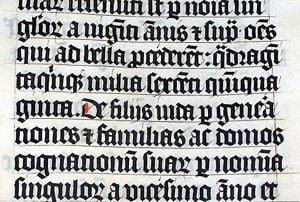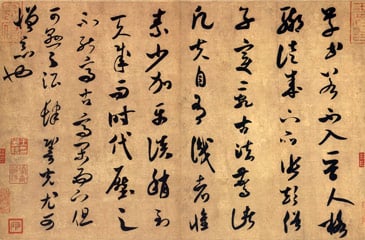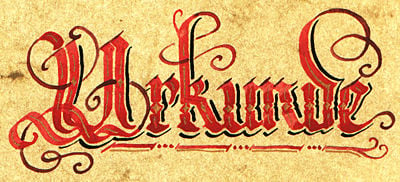Calligraphy
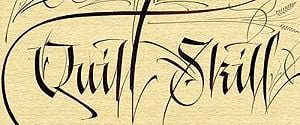
Calligraphy (from the Greek meaning κάλλος kallos "beauty" + γραφή graphẽ "writing") is a form of ornamental handwriting. A contemporary definition of calligraphic practice would be: "the art of giving form to signs in an expressive, harmonious and skillful manner" [1].
Calligraphic works range from functional inscriptions and hand lettering to fine art pieces where the artistic manifestation may take precedence over the legibility of the letters. Well-crafted calligraphy differs from typography and non-classical hand-lettering in that characters are disciplined yet fluid and spontaneous. Often they are improvised at the moment of writing.[2].
Calligraphy as an art form dates back to ancient times and plays a significant role in the history of many cultures and languages. Muslims were among those who valued calligraphy not only as art but as way to reflect the glory of God.[3] In present times, calligraphy continues to flourish in the form of wedding and event invitations, typography, original hand-lettered logo design, commissioned calligraphic art, maps, and other works involving writing.
Twentieth century calligraphy master, Edward Johnston, best described the process of writing calligraphy when he advised: "All rules must give way to Truth and Freedom" [4]
East Asian calligraphy
Calligraphy is considered an important art in East Asia and as the most refined form of East Asian painting.
It has influenced most major art styles, including 'sumi-e', a style of Chinese and Japanese ink and wash painting which uses similar tools and techniques and is based entirely on calligraphy.
East Asian calligraphy typically uses ink brushes to write Chinese characters which are called by various names: - 'Hanzi' in Chinese, 'Kanji' in Japanese, and 'Hanja' in Korean and Hán Tự in Vietnamese). The term calligraphy - in Chinese, Shufa 書法, in Japanese Shodō 書道, in Korean, Seoye 書藝 - all mean 'the way of writing.'
| The main categories of Chinese-character calligraphy | ||||
|---|---|---|---|---|
| English name | Hanzi(Pinyin) | Hangul (RR) | Rōmaji | Quốc ngữ |
| Seal script | 篆書(Zhuànshū) | 전서(Jeonseo) | Tensho | Triện thư |
| Clerical script (Official script) | 隸書 (隷書)(Lìshū) |
예서(Yeseo) | Reisho | Lệ thư |
| Regular Script (Block script) | 楷書(Kǎishū) | 해서(Haeseo) | Kaisho | Khải thư |
| Running script (Semi-cursive Script) | 行書(Xíngshū) | 행서(Haengseo) | Gyōsho | Hành thư |
| Grass script (Cursive script) | 草書(Cǎoshū) | 초서(Choseo) | Sōsho | Thảo thư |
Indian Calligraphy
Persian and Arabic script is thought to have influenced Indian calligraphy, although the scripts used are somewhat different. The flowing Persian script was thought to have influenced the writing style of Indian epics. Calligraphy in India was especially influenced by Sikhism whose holy book has been traditionally handwritten and illuminated. In ancient times the lack of modern printing technology resulted in a rich heritage of calligraphy in nearly dozens of Indian languages.
Tibetan Calligraphy
Calligraphy is central to Tibetan culture. The script is derived from Indic scripts. As in China, the nobles of Tibet, such as the High Lamas and inhabitants of the Potala Palace, were usually skilled calligraphers. For several centuries, Tibet has been a center of Buddhism, a religion that places a great deal of significance on the written word. This, however, does not give us a large body of secular pieces, although they do exist. Almost all high religious writing involved calligraphy, including letters sent by His Holiness, the Oracle of the Potala Palace, and other religious, and secular, figures of authority. Calligraphy is particularly evident on their prayer wheels, although this calligraphy was forged rather than scribed, much like Arab and Roman calligraphy is often found on buildings. Although originally done with a brush, Tibetan calligraphers now use chisel tipped pens and markers.
Persian calligraphy
Persian calligraphy is the calligraphy of the Persian writing system. The history of calligraphy in Persia dates back to the pre-Islam era. In Zoroastrianism, beautiful and clear writings were highly valued. [2] The three main forms of Persian calligraphy are called: Nasta'liq script, Shekasteh-Nasta'liq script and Naghashi-khat script.
Islamic calligraphy
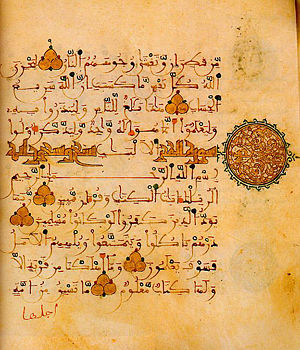
Islamic calligraphy is an aspect of Islamic art that has evolved alongside the religion of Islam and the Arabic language.
Arabic and Persian calligraphy is associated with geometric Islamic art (known as arabesque) which is found on the walls and ceilings of mosques as well as on paper. Contemporary artists in the Islamic world draw on their calligraphic heritage by using inscriptions or abstractions in their work.
Calligraphy has arguably become the most venerated form of Islamic art because it provides a link between the languages of the Muslims with the religion of Islam. The holy book of Islam, al-Qur'an has played an important role in the development and evolution of the Arabic language, and by extension, calligraphy in the Arabic alphabet. Proverbs and complete passages from the Qur'an are still sources for Islamic calligraphy.
There was a strong parallel tradition to that of the Islamic, among Aramaic and Hebrew language scholars, seen in such works as the Hebrew illustrated bibles of the 9th and 10th centuries.
Islamic Calligraphy has been an art form especially valued by Muslims who traditionally believed that only Allah could create images of people and animals and that they should not be represented in artwork.
Western calligraphy
Western calligraphy is the calligraphy of the Latin writing system, and to a lesser degree the Greek and Cyrillic writing systems. During the Middle Ages, hundreds of thousands of manuscripts were produced: many were illuminated with gold and fine painting.[5]
Christian churches promoted the development of writing through the prolific copying of the Bible, particularly the New Testament and other sacred texts. [6]Monks in the British Isles adapted the late Roman bookhand, 'Uncial', to develop a unique bookhand called "Celtic" or "Insular," meaning "of the islands." The 7th-9th centuries in northern Europe were the peak time for Celtic illuminated manuscripts, exemplified by the 'Lindisfarne Gospels' and the 'Book of Kells'.
Charlemagne helped the spread of beautiful writing by bringing Alcuin, the Abbot of York, to his capital of Aachen. Alcuin undertook a major revision of all styles of script and all texts, developing a new bookhand named after his patron Charlemagne.
Blackletter (also known as Gothic) and its variation Rotunda, gradually developed from the Carolingian hand during the 12th century. Over the next three centuries, the scribes in northern Europe used an ever more compressed and spiky form of Gothic. Those in Italy and Spain preferred the rounder but still heavy-looking Rotunda. During the 15th century, Italian scribes returned to the Roman and Carolingian models of writing and designed the Italic hand, also called Chancery cursive, and Roman bookhand. These three hands — Gothic, Italic, and Roman bookhand — became the models for printed letters. Johannes Gutenberg used Gothic to print his famous Bible, but the lighter-weight Italic and Roman bookhand have since become the standard.
Resurgence of Western Calligraphy
Hand-written and hand-decorated books largely stopped being produced by about 1510, after printing became ubiquitous [7]. However, at the end of the 19th century, William Morris and the Arts and Crafts Movement redefined, revived and popularized English broad-pen calligraphy. Morris influenced many calligraphers, including Englishmen Edward Johnston and Eric Gill. (Cockerell 1945). Edward Johnston developed his own broad-edged hand after studying 10th-century manuscripts.
Johnston, author of “Writing, Illuminating & Lettering” (1906) initially taught his students an uncial hand using a flat pen angle, but later changed to teaching students his “foundational hand” using a slanted pen angle. He first referred to this hand as “Foundational Hand” in his 1909 publication, Manuscript & Inscription Letters: For schools and classes and for the use of craftsmen.[8]
At about the same time as Johnston, Austrian Rudolf Larisch, who taught lettering at the Vienna School of Art, published six lettering books that greatly influenced German-speaking calligraphers. Because the German-speaking countries had not abandoned the Gothic hand in print, Gothic also had a powerful effect on their styles. Koch's books, type designs, and teaching made him one of the most influential calligraphers of the 20th century in northern Europe and later in the United States.
Copperplate
Copperplate is a style of calligraphic writing written with a sharp pointed nib instead of the broad-edged nib used in most calligraphic writing. The name comes from the sharp lines of the writing style resembling the etches of engraved copper. The Copperplate typeface attempts to emulate copper-engraved letters.
Copperplate obtains its name from the copybooks of the 18th and 19th centures, which were created by the engraving of copper printing plates using a transferred ink original. Students worked diligently to copy these works, although an exact replica could never be obtained, because the works were created originally from the chiselling of copper plates.
Calligraphy Today
Calligraphy continues to be used today in graphic design, logo design, maps, menus, greeting cards, invitations, legal documents, diplomas, poetry, business cards and handmade presentations. Many calligraphers find their "bread and butter" work in the addressing of calligraphic envelopes and invitations for weddings and large parties. The digital era has facilitated the creation and dissemination of new and historically related fonts; thousands are now in use. Calligraphy itself gives unique expression to every individual letterform, not possible with typeface technologies no matter their sophistication.[9]
The calligraphic art is no longer just about literal reproduction of historic and religious text. Written forms have become more abstract and are incorporated into works which have as much resonance with contemporary painting as they do with ancient manuscript writing. The Saint John's Illuminated Bible Project, has commissioned Donald Jackson, as of ??? , to hand illuminate the St. John's Bible, a feat that has not been executed in nearly 500 years. [3]
Notable calligraphers who have carried the calligraphic art into the new century also include, Thomas Ingmire, Hazel Dolby, Julian Waters, Sheila Waters, Denis Brown, Brody Neuenschwander, Hans-Joachim Burgert, Timothy Donaldson, Gottfried Pott, Paul Shaw, and Katharina Pieper.
Tools
The principal tools for a calligrapher are the pen, which may be flat- or round-nibbed and the brush. For certain decorative purposes, multi-nibbed pens — steel brushes — can be used. However, works have also been made with felt-tip pen and ballpoint pens, although these works do not employ angled lines. Ink for writing is usually water-based and much less viscous than the oil based inks used in printing. High quality paper, which has good porousness, will enable cleaner lines,[citation needed] although parchment or vellum is often used, as a knife can be used to erase work on them and a light box is not needed to allow lines to pass through it. In addition, light boxes and templates are often used in order to achieve straight lines without pencil markings detracting from the work. Lined paper, either for a light box or direct use, is most often lined every quarter or half inch, although inch spaces are occasionally used, such as with litterea unciales, and college ruled paper acts as a guideline often as well.
ReferencesISBN links support NWE through referral fees
- Cinamon, G. (2000) Rudolf Koch: Letterer, Type Designer, Teacher
- Cockerell, S. (1945) from "Tributes to Edward Johnston" in Child, H. & Howes, J. (ed.s, 1986) Lessons in Formal Writing, pp. 21-30.
- de Hamel, C. (2001) The Book. A History of the Bible
- de Hamel, C (1987) The Illuminated Manuscript
- Green, R. (2003). Bulley Bible (1969-83). Retrieved 28/10/2006, 2006, from http://palimpsest.stanford.edu/byform/mailing-lists/bookarts/2003/01/msg00132.html
- Herringham, C.J. (transl. 1899) The Book of the Art of Cennino Cennini, an English translation from the Italian
- Hewitt, G. (1930) Lettering: For Students & Craftsmen
- Jackson, D. (1981) The Story of Writing
- Johnston, E. (1906) Writing, Illuminating & Lettering
- Johnston, E. (1909) Manuscript & Inscription Letters: For schools and classes and for the use of craftsmen, plate 6
- Kapr, A. (1991) "Calligraphy 91" in Schreibwerkstaat Klingspor Offenbach
- Letter Arts Review
- Mediavilla, C. (1996) Calligraphy
- Neugebauer, F. (1979) The Mystic Art of Written Forms
- Pott, G. (2005) Kalligrafie:Erste Hilfe und Schrift-Training mit Muster-Alphabeten
- Prestianni, J. (2001) Calligraphic Type Design in the Digital Age
- Thomson, G. (2004) Digital Calligraphy with Photoshop
- Tresser, J. (1992) The Technique of Raised Gilding
- Whitley, K.P. (2000) The History and Technique of Manuscript Gilding, p.90.
- Zapf, H. (2006) The world of Alphabets: A kaleidoscope of drawings and letterforms, CD-ROM
External links
- Arabic Calligraphy: The Art of the Calligraphy Scripts in Islamic History/ Hasan Alia F.
- Muhammad Zakariya
- Islamic calligraphy
- Islamic Calligraphies in the Library of Congress, Washington D.C.
- Saint John's Bible
- Caligraft — Computational calligraphy
- Islamic Calligraphy Some articles and examples of Islamic-Turkish Calligrahy (in Turkish)
- The Edward Johnston Foundation
- New Zealand Calligraphers
- Turkish Calligrapher
- Left-handed calligrapher - French maltese
- ↑ Mediavilla, C. (1996) 18
- ↑ Pott, G. (2005) Kalligrafie:Erste Hilfe und Schrift-Training mit Muster-Alphabeten
- ↑ http://www.suite101.com/article.cfm/arabic_islamic_architecture/28162
- ↑ Johnston, E. (1906) Writing, Illuminating & Lettering.
- ↑ de Hamel, C (1987) The Illuminated Manuscript
- ↑ de Hamel, C. (2001) The Book. A History of the Bible
- ↑ de Hamel, C. (1986)The Book. A History of the Bible
- ↑ Johnston, E. (1909) Manuscript & Inscription Letters: For schools and classes and for the use of craftsmen, plate 6.
- ↑ Thomson, G. (2004) Digital Calligraphy with Photoshop
